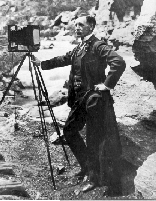William Henry Jackson
William Henry Jackson (born April 4, 1843 in Keeseville , New York , † June 30, 1942 in New York City , New York ) was an American photographer , painter and adventurer. He became famous primarily for his photos of the American West.
Jackson's wandering years
Jackson grew up in New England . At the age of 15 he started working as a photo retoucher in Vermont . In the American Civil War , which broke out a little later , Jackson actively fought, including in the Battle of Gettysburg . After the war, he first settled in Saint Joseph , drove freight trucks over the Oregon Trail to Salt Lake City and then drove Mustangs from Los Angeles to Omaha , a grueling 2000 kilometer stretch from the west coast to the geographic center of the USA. In Omaha, he started a photography business with his brother. In 1869 he was commissioned by the Union Pacific Railroad to record the scenery along its route for advertising purposes. In the following year he received an invitation to take part first in the Hayden expedition to the area of Yellowstone National Park and then on further research trips to the Mesa Verde ruins, the mountains in Colorado and the pueblos in the southwest.
First Yellowstone photographer
Jackson worked closely with the painter Thomas Moran on the expedition to the Yellowstone area . Jackson was the first photographer to capture the legendary landscape of the Yellowstone area, untouched by modern civilization.
Jackson worked with three cameras in mostly difficult conditions; a stereo camera , an 8 x 10 inch and an 18 x 22 inch plate camera . These cameras required fragile, heavy photo plates whose substrate was glass and which had to be individually anti-reflective, exposed and developed by hand on site before the wet collodium coating dried. Depending on the lighting conditions, he had between five seconds and twenty minutes. The preparation, exposure, fixing, washing and drying operations usually required around an hour for a single image.
Jackson carried his equipment on the back of mules. The weight of the glass plates and the portable dark room limited the number of possible shots of a trip. The recordings were also made in impassable terrain so that the pack animals could not be stressed to the extreme.
Despite these difficulties, Jackson returned with photographic evidence back one until that time unknown landscape in civilization, among them were pictures of the Grand Teton MOUNTAINS, the geyser Old Faithful , the Mount of the Holy Cross and the uncooperative Ute - Indians . Jackson's recordings contributed significantly to the fact that the American Congress declared a large part of the Yellowstone area to be the first national park in the world on March 1, 1872 .
Established photographer
Jackson contributed photographs and clay models of the Anasazi homes at Mesa Verde to the Philadelphia centenary exhibition in 1876 . He then took part in further studies under the direction of Ferdinand V. Hayden until 1878 and then set up his own studio in Denver , where he created large collections of national and international recordings. He was commissioned to take photographs of the western states for the 1893 World's Fair in Chicago . After the world exhibition he toured Europe, Africa, Australia, India, Japan and Russia on behalf of a new museum in Chicago. His photos and reports were published in Harper's Weekly magazine; Jackson is one of the first photojournalists who became known for their travel reports in printed periodicals.
After writing his autobiography, he sold his entire collection of negatives to the Detroit Photographic Company in the early years of the 20th century . In the 1920s they were split between the Colorado Historical Society and the Library of Congress Prints and Photographs Division . The recordings west of the Mississippi River went to the Society, all other recordings went to the Library of Congress, which is now famous for its collection.
In 1924 Jackson moved to Washington, DC and was involved in building the US Department of the Interior . He also worked as a technical consultant on the filming of Gone With the Wind . In 1942 he was honored by the Explorer's Club for his 80,000 photographs of the American West.
Jackson died at the age of 99. As one of the last survivors of the American Civil War, he was buried in Arlington National Cemetery , the most famous military cemetery in the United States.
Today, Scotts Bluff National Monument in Nebraska has the largest collection of Jackson's paintings.
literature
- Peter B. Hales: William Henry Jackson and the Transformation of the American Landscape. Temple University Press, Philadelphia PA 1988, ISBN 0-87722-478-1 .
-
Ferdinand Vandiveer Hayden and the founding of the Yellowstone National Park . With Sketches by Thomas Moran and Photographs by WH Jackson. Department of the Interior, Geological Survey (US)
- Photographs of the Yellowstone National Park by WH Jackson
- Photographs of Indians. Selected From the Collection in the Possession of the US Geological Survey of the Territories. Prof. FV Hayden in charge. Representing 70 different tribes . Printed 1876
Web links
Celebrating the American West: 19th Century Mammoth Plate Photographs . Exhibited in the Gridman Gallery: Carleton E. Watkins - Frank Jay Haynes - William Henry Jackson
| personal data | |
|---|---|
| SURNAME | Jackson, William Henry |
| BRIEF DESCRIPTION | American photographer |
| DATE OF BIRTH | April 4, 1843 |
| PLACE OF BIRTH | Keeseville , New York |
| DATE OF DEATH | June 30, 1942 |
| Place of death | New York City , New York |

